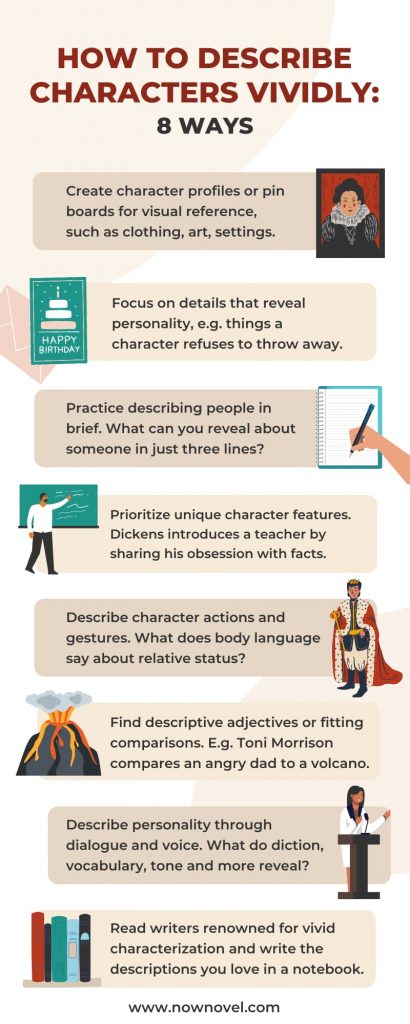Knowing how to describe a person so that your reader forms a vivid impression is vital for immersive writing. How can you describe a person precisely and avoid pace-crushing info dumps or eyes, eyes, eyes? Read 8 ways to write better, varied character description:
8 ways to describe people in a story
- Start with character profiles and pin boards
- Focus on details that reveal personality, use detailed descriptive language
- Practice describing people in brief
- Prioritize unique character features
- Describe character actions and gestures
- Find descriptive precise adjectives and fitting comparisons, use descriptive verbs too
- Describe personality via dialogue and voice
- Read writers renowned for good characterization
Let's dive into each of these ideas for bringing your characters to life:
1. Start with character profiles and pin boards
Before you begin describing people who'll populate your story, it's useful to sketch character ideas. It helps if you can answer questions such as:
- What clothing does my character wear?
- What is idiosyncratic or recognizable about how my character moves? What does their body language reveal?
- What would a stranger notice first about this character if they entered a room?
- What is their physical description? What is their eye and hair color, do they have freckles, scars or tattoos?
To build richer descriptions, you could create a pin board on Pinterest before you draft of clothing your character would wear, places they might love to visit. Any visual reference point that captures the essence of their persona.

2. Focus on details that reveal personality
A character's hair or eye color doesn't tell the reader much (there are other ways to use eye descriptions to build personality).
When you introduce a character, focus on details that reveal character personality or psychology.
Here's Dostoevsky describing his character Katerina Ivanova (who has tuberculosis) in Crime and Punishment (1866):
Describe habitual actions to reveal personality
Katerina Ivanovna had just begun, as she always did at every free moment, walking to and fro in her little room from window to stove and back again, with her arms folded across her chest, talking to herself and coughing.
Fyodor Dostoevsky, Crime and Punishment (1866), Chapter 7.
Dostoevsky conveys Katerina's fragile mental health and state clearly. The coughing is a reminder of her life-threatening condition. The fact she continues to pace despite her discomfort suggests her determined, fighting spirit, which we see in further scenes.
You could also use descriptions of a character's physical appearance to show their personalities, for example: 'Jenna's curly hair was bouncy, like her character. bouncy and bubbly.'
Use objects such as possessions left behind to suggest persona
The acclaimed short story author Alice Munro is a master of understated character development.
In her story 'Free Radicals', Munro describes a recently-widowed woman named Nita coming to terms with her husband's death:
She thought carefully, every morning when she first took her seat, of the places where Rich was not. He was not in the smaller bathroom, where his shaving things still were, along with the prescription pills for various troublesome but not serious ailments which he'd refused to throw out.
Alice Munro, 'Free Radicals', available via The New Yorker
Munro creates the emotional affect of a deceased spouse's absence by describing objects in detail that remain once they've gone.
A precise detail - the prescription pills Rich refused to throw out - describes something about his hoarding character.
Detail the type of behavior characters might exhibit
Another way to describe a character's personality is to give an example of something they might do.
Further on in the story, Munro describe pranking behavior that was typical of Rich to suggest a playful nature:
He was of course not out on the half-scraped deck, ready to peer jokingly in the window - through which she might, in earlier days, have pretended to be alarmed at the sight of a peeping tom.
Munro, 'Free Radicals'
The details Munro shares combine character behavior (Rich's joking at the window) and setting detail (pills left behind that he refused to discard) to simultaneously create a sense of character and place. Her details describe the way people inhabit their spaces. This creates Rich as a vivid, lingering, ghostly presence in Nita's memory.
3. Practice describing people in brief
One thing to avoid in choosing how to describe a character in a story is an info dump.
Info-dumping character description makes your reader go, 'Oh, the author wants to squeeze in everything they possibly can about their character.' It alerts your reader to the author's hand, the wizard behind the curtain conjuring Oz. Such spurious description may lose your reader.
Instead, pick a specific detail to focus on for an introduction, and bring in other visual or descriptive character details as they become relevant to the story/action.
Examples of how to describe people succinctly
Here are a few examples of character descriptions that are precise and impactful:
Her hair had been long and wavy brown then, natural in curl and colour, as he liked it, and her face bashful and soft - a reflection less of the way she was than of the way he wanted to see her.
Alice Munro, 'Dimensions', Too Much Happiness (2009), p. 2. Available online.
Note how Munro succinctly creates a sense not only of a character's appearance but how it is affected by her being in a controlling relationship (which we find out more about as the story continues).
A sense of time and change is bundled with character description as we read a factor that shaped the protagonist Doree's past appearance, now changed at the story's start.
Below, Kent Haruf uses simile drawn from two elderly brothers' farmland world to describe their appearance:
Their faces were red and weather-blasted below their white foreheads, the coarse hair on their round heads grown iron-gray and as stiff as the roached mane of a horse.
Kent Haruf, Eventide (2004), p. 3.
Practice describing characters in three lines or less. What can you compare their appearance to? What does it say about them?

4. Prioritize unique character features
A large part of learning how to describe a person believably is showing what makes them unique or distinctive.
The Victorian author Charles Dickens, a master of characterization, described people with vivid, characteristic humor.
Here Dickens describes the schoolmaster Thomas Gradgrind, 'a man of facts and calculations' in his novel Hard Times (1854):
The emphasis was helped by the speaker's voice, which was inflexible, dry, and dictatorial. The emphasis was helped by the speaker's hair, which bristled on the skirts of his bald head, a plantation of firs to keep the wind from its shining surface, all covered with knobs, like the crust of a plum pie, as if the head had scarcely warehouse-room for the hard facts stored inside.
Charles Dickens, Hard Times (1854), full text on Project Gutenberg.
Although Dickens describes his character's hair, he uses a striking visual metaphor ('a plantation of firs').
This leads quickly back to description showing the schoolmaster's fact-obsessed nature ('...as if the head had scarcely warehouse-room for the hard facts stored inside').
Dickens takes the description of Gradgrind as obstinate and fact-obsessed further:
The speaker's obstinate carriage, square coat, square legs, square shoulders, - nay, his very neckcloth, trained to take him by the throat with an unaccommodating grasp, like a stubborn fact, as it was, - all helped the emphasis.
Dickens, Hard Times
Thus Dickens mines a single, defining detail - Gradgrind's tyrannical obsession with fact over imagination - for cohesive, comical description.
If Dickens had simply said 'he was balding and inflexible and would lecture the students about facts', this would create some sense of character. Dickens instead writes stronger description to show us what the character is like.
Yet the unique details Dickens chooses make Thomas Gradgrind especially vivid.

5. Describe character actions and gestures
Showing characters' gestures and actions is an important part of bringing characters to life.
The way your characters move, their body language and gestures, is a key part of describing personality, status, or mental state.
In the example from Dostoevsky above, Katerina Ivanovna's anxious pacing conveys her mounting fear over her husband (who drinks away the little money they have).
In Hard Times, Dickens uses movement and body language to reinforce the impression of Gradgrind as domineering and forceful:
"Girl number twenty," said Mr. Gradgrind, squarely pointing with his square forefinger, "I don't know that girl. Who is that girl?"
"Sissy Jupe, sir," explained number twenty, blushing, standing up, and curtseying.
Dickens, Hard TImes
Dickens extends Gradgrind's 'squareness' through his pointing. Sissy Jupe's own body language conveys both her own bashfulness and the fact that Gradgrind wields stern authority over his pupils.
Dickens could simply use dialogue for the schoolmaster's inquiry. Because of Gradgrind's gestures, though, we get a clear sense of his dominant, demanding persona.
6. Find descriptive adjectives and fitting comparisons
There are two useful tools for accurate description of characters in stories: Precise, exact adjectives, and comparative language.
Finding adjectives to describe people with positive and negative connotations
Positive adjectives to describe a person include:
- Kindness: Kind, fair, caring, thoughtful, non-judgmental, respectful, loving
- Conscientiousness: Principled, upstanding, disciplined, rigorous, thorough, careful, decisive
- Selflessness: Selfless, giving, generous, dedicated
- Intelligence: Smart, insightful, perceptive, brainy, whip-smart, aware, informed, knowledgeable
- Attractive: Beautiful, stunning, gorgeous, hot, sexy, alluring, glamorous, studly, magnetic, hypnotic, fit [UK slang]
These are just some adjectives to describe a person in positive terms. If you need a good word for description:
- Look up a similar, broader word in a thesaurus.
- Find a word you like and look up its full definition and even etymology to ensure it has the right connotations (latent or associated meanings).
Negative adjectives to describe a person might include:
- Cruelty: Cruel, unkind, nasty, vicious, wicked, evil, despicable, malevolent, vindictive
- Ugliness: Hideous, vile, gross, creepy, fugly, monstrous, disgusting
- Boring: Dull, dreary, insufferable, tedious, insipid, bland
- Non-intelligence: Stupid, thick, ignorant, cretinous, basic
Keep in mind that some words to describe people negatively may have socially-offensive connotations (for example 'dumb' in the informal sense to mean stupid comes from 'mute').
If in doubt, find the most exact adjective whose connotations cannot be read another way.
Find fitting comparisons and use figurative language describing character
Comparisons are a great tool for writing character descriptions that are vivid.
Look at how Dickens describes Gradgrind's bald head in the example above, for example. Dickens uses metaphor (there is no 'like' or 'as though' which would make it a simile): '[Gradgrind's hair] bristled on the skirts of his bald head, a plantation of firs to keep the wind from its shining surface.'
Now this isn't the most fitting description (Gradgrind's head has nothing to do with trees or a plantation of firs). Yet it conjures a precise, memorable image.
In Toni Morrison's Song of Solomon, a father's anger is shown using the metaphor of a volcano likely to erupt at an time.
Morrison extends this metaphor beautifully to show how Macon's (the father) anger affects his daughters:
Solid, rumbling, likely to erupt without prior notice, Macon kept each member of his family awkward with fear. His hatred of his wife glittered and sparked in every word he spoke to her. The disappointment he felt in his daughters sifted down on them like ash, dulling their buttery complexions and choking the lilt out of what should have been girlish voices.
Toni Morrison, Song of Solomon (1978), p. 10.
7. Describe personality via dialogue and voice
In deciding how to describe characters in your story, dialogue and voice in narration are two powerful tools to create a persona.
People's speech describes so much about who they are:
- Tone: Is a person often angry, huffy, disappointed (like Macon in the example by Toni Morrison above)
- Vocabulary: Does the person have an extensive vocabulary suggesting they are educated or well-read or the opposite?
- Diction: Does the character have a marked accent, drawl, lisp or other distinguishing feature of the way they speak?
- Voice: What are the actual timbral qualities of your character's voice? Is it high, low, or in-between? Loud or soft? Grating or pleasant to the hearer?
What your characters talk about (and what they leave unsaid) describes their persona in addition to visual descriptive details.
8. Read writers renowned for their characterization
To learn how to describe a person brilliantly, collect memorable character descriptions. Read authors who are particularly noted for their vivid characters.
Many short story authors (such as Anton Chekhov) are good at compressing character detail into shorter passages.
Here, for example, is Chekhov describing his character Mihail Petrovitch Zotov, an old man, through dialogue and action tags in his story 'The Dependents':
"What an existence!" he grumbled, rolling crumbs of black bread round in his mouth. "It's a dog's life. No tea! And it isn't as though I were a simple peasant: I'm an artisan and a house-owner. The disgrace!"
Anton Chekhov, 'The Dependents', available online.
Chekhov combines this portrait of the character's psychological state with description of his appearance:
Grumbling and talking to himself, Zotov put on his overcoat, which was like a crinoline, and, thrusting his feet into huge clumsy golosh-boots (made in the year 1867 by a bootmaker called Prohoritch), went out into the yard.
Chekhov, 'The Dependents'.
Start keeping a journal where you collect character descriptions that strike you as effective. This can become a useful source of inspiration to page through when you are sketching out your own characters.
Before concluding, let's briefly take a look at how to detail character if you are writing in the first person. So far, we have looked at how to describe when you are writing in the third person point of view. First person description examples will need to be slightly different as you don't have access to the omniscient narrator device.
There are various ways to do so, however, and effectively. For example another character could comment on the appearance of the first-person character. Here are some ways:
'John looked at me with a shocked expression and asked why I had black dots under my eyes.'
'I glanced into the mirror, and noticed my mascara had smudged, leaving a trail of black dots under each eye.'
Ready to flesh out your characters and get feedback on character descriptions? Start outlining characters, and get constructive feedback from the Now Novel community when you're ready to revise.










Great post :) Thanks for the tips!
Amy Nikita - Over 8 years ago
Thanks, Amy! It's a pleasure. Thanks for reading.
Bridget At Now Novel - Over 8 years ago
My name is Muhammad saqlain mushtaq I am from pakistan
M Saqlain Mushtaq - Over 2 years ago
Hi Muhammad, welcome to our blog. Let me know if you have any questions about character description (or anything else writing related) and I'll do my best to answer them.
Jordan - Over 2 years ago
Thanks for very descriptive and inspiring inputs. Impressive and very helpful. This is helpful not only for me but also for everyone. My salute .
Alex Dalusong, Jr. - Over 2 years ago
Hi Alex, it's a pleasure. Thank you for reading our blog.
Jordan - Over 2 years ago
Hi😊 It's your newest fan here. Thanks Jordan😊
Glajol Godson - About 2 years ago
Hi Glajol, I'm glad you're a fan of our blog. Thank you for reading and saying hi.
Jordan - About 2 years ago
I feel like everything you wrote was meant for me because I'm having alot of trouble describing my characters,so thanks alot
Kaitlyn Zulu - About 2 years ago
Hi Kaitlyn, I'm so glad to hear that. Hope your story goes well further.
Jordan - About 2 years ago
Jordan- Wow! This information on building vivid characters is exactly what I was looking for. I am in the early stage of my writing career and struggling with describing my scene or setting and characters. Thank you for providing this resource. This information is great!
Melika Black - Over 1 year ago
Dear Melika, Thanks so much for your comments! So pleased to hear them. All the very best with your writing.
Arja Salafranca - Over 1 year ago